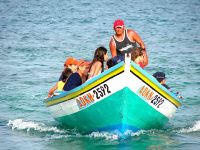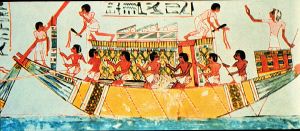Difference between revisions of "Boat" - New World Encyclopedia
| Line 1: | Line 1: | ||
| − | {{ | + | {{Claimed}} |
| − | + | {{otheruses}} | |
| − | A boat' | + | A '''boat''' is a [[watercraft]] designed to float or plane on, and provide transport over, water. Usually this water will be inland (lakes) or in protected coastal areas. However, boats such as the [[whaleboat]] were historically designed to be operated from a [[ship]] in an offshore environment. In Naval terms, a boat is something small enough to be carried aboard another vessel (a ship). Boats that are notable exceptions to this concept due to their large size are the [[lake freighter|Great Lakes freighter]], [[riverboat]], [[narrowboat]] and [[ferry]]boat. These examples do, however, generally operate on inland and protected coastal waters. Modern submarines may also be referred to as boats (in spite of underwater capabilities and size), but this is possibly due to the fact that the first submarines could be carried by a ship and were certainly not capable of making offshore passages on their own. Boats may have military, other government, research, or commercial usage; but a vessel, regardless of size, that is in private, non-commercial usage is almost certainly a boat. |
[[Image:Boating in fair weather.jpg|thumb|right|200px|A wooden boat operating near shore.]] | [[Image:Boating in fair weather.jpg|thumb|right|200px|A wooden boat operating near shore.]] | ||
| Line 8: | Line 8: | ||
==Parts of a boat== | ==Parts of a boat== | ||
{{seealso|Glossary of nautical terms|Naval architecture}} | {{seealso|Glossary of nautical terms|Naval architecture}} | ||
| − | [[Image:EgyptTombOarboat.jpg|thumb|A boat in an Egyptian tomb painting from about 1450 | + | [[Image:EgyptTombOarboat.jpg|thumb|A boat in an Egyptian tomb painting from about 1450 B.C.E.]] |
| − | The roughly horizontal, but cambered structures spanning the [[hull (watercraft)|hull]] of the boat are referred to as the "deck" | + | The roughly horizontal, but cambered structures spanning the [[hull (watercraft)|hull]] of the boat are referred to as the "deck." In a ship there are often several, but a boat is unlikely to have more than one. The similar but usually lighter structure which spans a raised cabin is a coach-roof. The "floor" of a cabin is properly known as the sole but is more likely to be called the floor. (A floor is properly, a structural member which ties a frame to the keelson and keel.) The underside of a deck is the deck head. The keel is a lengthwise structural member to which the frames are fixed (sometimes referred to as a backbone). The vertical surfaces dividing the internal space are bulkheads. The front of a boat is called the bow or prow. The rear of the boat is called the stern. The right side is starboard and the left side is port.On old time boats,a [[Figurehead]] sits on the front of the bow. |
| − | |||
| − | The vertical surfaces dividing the internal space are | ||
==Types of boats== | ==Types of boats== | ||
| Line 17: | Line 15: | ||
[[Image:mutandbarge.jpg|thumb|250px|A sailboat (racing dinghy) and barge share the [[Mississippi River]], USA.]] | [[Image:mutandbarge.jpg|thumb|250px|A sailboat (racing dinghy) and barge share the [[Mississippi River]], USA.]] | ||
{| | {| | ||
| − | | | + | |— |
| | | | ||
| − | * [[Air boat]] | + | * [[Air boat]] |
| − | * [[Banana boat]] | + | * [[Banana boat]] |
| − | * [[Outrigger canoe|Bangca]] | + | * [[Outrigger canoe|Bangca]] |
| − | * [[Bareboat charter]] | + | * [[Bareboat charter]] |
| − | * [[Barge]]* | + | * [[Barge]] |
| − | * [[Bow Rider]] | + | * [[Bellyboat]] |
| − | * [[Cabin cruiser]] | + | * [[Bow Rider]] |
| − | * [[Canoe]] | + | * [[Cabin cruiser]] |
| − | * [[Cape Islander]] | + | * [[Canoe]] |
| − | * [[Car-boat]] | + | * [[Cape Islander]] |
| − | * [[Caravel]] | + | * [[Car-boat]] |
| − | + | * [[Caravel]] | |
| − | * [[Catamaran]] | + | * [[Catamaran]] |
| − | * [[Catboat]] | + | * [[Catboat]] |
| − | * [[Coble]] | + | * [[Coble]] |
| − | * [[Center Console (boat)|Center Console]] | + | * [[Center Console (boat)|Center Console]] |
| − | * [[Coracle]] | + | * [[Coracle]] |
| − | * [[Cruising (maritime)|Cruiser]] | + | * [[Cruising (maritime)|Cruiser]] |
| − | * [[ | + | * [[Cruising trawler]] |
| − | * [[ | + | * [[Cuddy]] |
| − | * [[Cutter]] | + | * [[Cutter (ship)|Cutter]] (sailing boat) |
| − | * [[Dhow]] | + | * [[Dhow]] |
| − | * [[Dinghy]] | + | * [[Dinghy]] |
| − | * [[Dory]] | + | * [[Dory]] |
| − | * [[Dragon boat]] | + | * [[Dragon boat]] |
| − | |||
| − | |||
| − | |||
| − | |||
| − | |||
| − | |||
| − | |||
| | | | ||
| − | * [[ | + | * [[Dredge]] |
| − | * [[ | + | * [[McKenzie River dory|Drift Boat]] |
| − | * [[ | + | * [[Durham Boat]] |
| − | * [[ | + | * [[Express Cruiser]] |
| − | * [[ | + | * [[Felucca]] |
| − | * [[ | + | * [[Ferry]] |
| − | * [[ | + | * [[Fireboat]] |
| − | * [[ | + | * [[Fishing boat]] |
| − | + | * [[Flyak]] | |
| − | * [[ | + | * [[Folding boat]] |
| − | * [[ | + | * [[Go-fast boat]] |
| − | * [[ | + | * [[Gondola]] |
| − | + | * [[lake freighter|Great Lakes freighter]] | |
| − | * [[ | + | * [[Houseboat]] |
| − | * [[ | + | * [[Hovercraft]] |
| − | * [[ | + | * [[Hydrofoil]] |
| − | * [[ | + | * [[Hydroplane]] |
| − | * [[ | + | * [[Inflatable boat]] |
| − | * [[ | + | * [[Jetboat]] |
| − | * [[ | + | * [[Jet ski]] |
| − | * [[ | + | * [[Jon boat]] |
| − | * [[ | + | * [[Junk (ship)|Junk]] |
| − | * [[ | + | * [[Kayak]] and [[Sea kayak]] |
| − | + | * [[Ketch]] | |
| − | * [[ | ||
| − | |||
| − | |||
| − | |||
| − | |||
| − | * [[ | ||
| − | |||
| − | * [[ | ||
| − | |||
| − | |||
| | | | ||
| − | * [[Raft]] | + | * [[Landing craft]] |
| − | * [[Rigid-hulled inflatable boat]] | + | * [[Lifeboat]] |
| − | * [[Riverboat]] | + | * [[Dugout (boat)|Log boat]] |
| − | * [[Runabout (boat)|Runabout]] | + | * [[Longboat]] |
| − | * [[Watercraft rowing|Rowboat]] | + | * [[Longtail]] |
| − | * [[Sailboat]] | + | * [[Luxury yacht]] |
| − | * [[Sampan]] | + | * [[Motorboat]] |
| − | * [[Schooner]] | + | * [[Narrowboat]] |
| − | * [[Scow]] | + | * [[Norfolk wherry]] |
| − | + | * [[Outrigger canoe]] | |
| − | * [[Sharpie (boat)|Sharpie]] | + | * [[Padded V-hull]] |
| − | * [[Shikaras]] | + | * [[Personal water craft]] (PWC) |
| − | * [[Ship's tender]] | + | * [[Pinnace]] |
| − | * [[Ski boat]] | + | * [[Pirogue]] |
| − | * [[Skiff]] | + | * [[Pleasure craft]] |
| − | * [[steam boat]]* | + | * [[Pontoon]] |
| − | * [[Sloop]] | + | * [[Motorboat|Powerboat]] |
| − | * [[Submarine]] | + | * [[Punt (boat)|Punt]] |
| − | * [[Surfboat|Surf boat]] | + | * [[Raft]] |
| − | * [[Fast Patrol Craft|Swift boat]] | + | * [[Rigid-hulled inflatable boat|Rigid-hulled inflatable]] |
| − | * [[Tarai Bune]] | + | * [[Riverboat]] |
| − | + | * [[Runabout (boat)|Runabout]] | |
| − | * [[Trimaran]] | + | * [[Watercraft rowing|Rowboat]], rowing boat |
| − | * [[Trawler|Trawler (fishing)]] | + | * [[Sailboat]], sailing boat |
| − | + | * [[Sampan]] | |
| − | * [[Tugboat]] | + | | |
| − | * [[U-boat]] | + | * [[Schooner]] |
| − | * [[Waka (canoe)|Waka]] | + | * [[Scow]] |
| − | * [[Wakeboard boat]] | + | * [[Sharpie (boat)|Sharpie]] |
| − | * [[Walkaround (boat)|Walkaround]] | + | * [[Shikaras]] |
| − | * [[Water taxi]] | + | * [[Ship's tender]] |
| − | * [[Whaleboat]] | + | * [[Ski boat]] |
| − | * [[Yachting|Yacht]] | + | * [[Skiff]] |
| − | * [[Yawl]] | + | * [[steam boat]] |
| + | * [[Slipper Launch]] | ||
| + | * [[Sloop]] | ||
| + | * [[Submarine]] | ||
| + | * [[Surfboat|Surf boat]] | ||
| + | * [[Fast Patrol Craft|Swift boat]] | ||
| + | * [[Tarai Bune]] | ||
| + | * [[Trimaran]] | ||
| + | * [[Trawler|Trawler (fishing)]] | ||
| + | * [[Tugboat]] | ||
| + | * [[U-boat]] | ||
| + | * [[Waka (canoe)|Waka]] | ||
| + | * [[Wakeboard boat]] | ||
| + | * [[Walkaround (boat)|Walkaround]] | ||
| + | * [[Water taxi]] | ||
| + | * [[Whaleboat]] | ||
| + | * [[Yachting|Yacht]] | ||
| + | * [[Yawl]] | ||
|} | |} | ||
| − | Unusual boats have been used for sports purposes - for example, in "bathtub races" which use boats made from bathtubs. Pumpkins have been used as boats as in the annual Pumpkin Boat Race on Lake Otsego in New York state, USA. In this race, very large, hollowed out pumpkin shells are used for boats, powered by canoe paddles. <!-- note: this pumpkin stuff sounded like a joke so I checked on Google and it is true! —> | + | Unusual boats have been used for sports purposes - for example, in "big bathtub races" which use boats made from bathtubs. Pumpkins have been used as boats as in the annual Pumpkin Boat Race on Lake Otsego in New York state, USA. In this race, very large, hollowed out pumpkin shells are used for boats, powered by canoe paddles. <!-- note: this pumpkin stuff sounded like a joke so I checked on Google and it is true! —> |
== Boat building materials == | == Boat building materials == | ||
{{seealso|Boat building}} | {{seealso|Boat building}} | ||
| − | [[Image:DerelictBoatFollyIs.jpg|thumb|250px|right|Derelict|A ship's lifeboat, built of steel, | + | [[Image:DerelictBoatFollyIs.jpg|thumb|250px|right|Derelict|A ship's lifeboat, built of steel, rusting away in the wetlands of [[Folly Island]], [[South Carolina]], [[United States]].]] |
| − | Until the mid 19th century all boats were | + | Until the mid 19th century most boats were of all natural materials; primarily wood. Many boats had been built with iron or steel frames but still planked in wood. In 1855 ferro-cement boat construction was patented by the French. They called it Ferciment. This is a system by which a steel or iron wire framework is built in the shape of a boat's hull and covered ([[trowel]]ed) over with cement. Reinforced with bulkheads and other internal structure it is strong but heavy, easily repaired, and, if sealed properly, will not leak or corrode. These materials and methods were copied all over the world, and have faded in and out of popularity to the present. As the forests of Britain and Europe continued to be over-harvested to supply the keels of larger wooden boats, and the [[Bessemer Process]] (patented in 1855) cheapened the cost of steel, steel ships and boats began to be more common. By the 1930s boats built of all steel from frames to plating were seen replacing wooden boats in many industrial uses, even the fishing fleets. Private recreational boats in steel are uncommon. In the mid 20th century aluminium gained popularity. Though much more expensive than steel, there are now aluminum alloys available that will not corrode in salt water, and an aluminum boat built to similar load carrying standards could be built lighter than steel.Nowdays fibre glass is dominating boat industry. |
| + | |||
| + | Platt Monfort invented Wire Plank(r)(1969), Fer-a-Lite(r)(1972), Str-r-etch Mesh(r)(1975), and Geodesic Airolite Boats(r)(1981). Fer-A-Lite(r) is a mixture of polyester resin, fiberglass, and a filler. This, along with Str-r-etch Mesh(r), could be used to build a boat in the same fashion as a ferro-cement boat, but the resulting hull would be much lighter and more resilient. Wire Plank(r) was first used in ferro-cement construction, but could also be used with Fer-a-Lite to create a medium to heavy weight hull. Geodesic Airolite Boats(r) are built using very lightweight wooden frames ([[geodesic]]) that are covered over with some lightweight heatshrinkable plastic or a synthetic fabric such as dacron coated with sealant. This tensioned skin adds to the overall strength of the structure and boats built thus are of the ultra-light variety. Boats come in many different shapes and sizes. Why? SO that some boats will be used perfectly against different types of waves. | ||
| + | |||
| + | Around the mid 1960s, boats made out of [[glass-reinforced plastic]], more commonly known as [[fiberglass]], became popular, especially for recreational boats. The [[United States Coast Guard|coast guard]] refers to such boats as 'FRP' (for Fiberglass Reinforced Plastic) boats. | ||
| + | Fiberglass boats are extremely strong, and do not rust, corrode, or rot. They are, however susceptible to structural degradation from sunlight and extremes in temperature over their lifespan. Fiberglass provides structural strength, especially when long woven strands are laid, sometimes from bow to stern, and then soaked in epoxy or polyester resin to form the hull of the boat. Whether hand laid or built in a mold, FRP boats usually have an outer coating of gelcoat which is a thin solid colored layer of polyester resin that adds no structural strength, but does create a smooth surface which can be buffed to a high shine. One of the disadvantages of fiberglass is that it is heavy and to alleviate this, various lighter components can be incorporated into the design. One of the more common methods is to use cored FRP, with the core being balsa wood completely encased in fiberglass. Cored FRP is most often found in decking which helps keep down weight that will be carried above the waterline. While this works, the addition of wood makes the cored structure of the boat susceptible to rotting. The phrase 'advanced composites' in FRP construction may indicate the addition of carbon fiber, kevlar(tm) or other similar materials, but it may also indicate other methods designed to introduce less expensive and, by at least one yacht surveyor's eyewitness accounts [http://www.yachtsurvey.com/Fiberglass_Boats.htm], less structurally sound materials. | ||
| − | + | Cold molding is similar to FRP in as much as it involves the use of epoxy or polyester resins, but the structural component is wood instead of fiberglass. In cold molding very thin strips of wood are laid over a form or mold in layers. This layer is then coated with resin and another directionally alternating layer is laid on top. In some processes the subsequent layers are stapled or otherwise mechanically fastened to the previous layers, but in other processes the layers are weighted or even vacuum bagged to hold layers together while the resin sets. Layers are built up thus to create the required thickness of hull. | |
| − | [[ | + | People have even made their own boats or watercraft out of commonly available materials such as [[styrofoam]] or plastic, but most homebuilts today are built of plywood and either painted or covered in a layer of fiberglass and resin. |
== Boat propulsion== | == Boat propulsion== | ||
| Line 139: | Line 142: | ||
*Human power (rowing, paddling, [[setting pole]] etc.) | *Human power (rowing, paddling, [[setting pole]] etc.) | ||
| − | *Wind power ( | + | *Wind power ([[Sails|sail]]ing) |
*Motor powered [[Propeller|screws]] | *Motor powered [[Propeller|screws]] | ||
**[[Inboard motor|Inboard]] | **[[Inboard motor|Inboard]] | ||
***Internal Combustion (gasoline, diesel) | ***Internal Combustion (gasoline, diesel) | ||
***Steam (Coal, [[fuel oil]]) | ***Steam (Coal, [[fuel oil]]) | ||
| − | ***Nuclear (for | + | ***Nuclear (for large boats) |
**[[Sterndrive|Inboard/Outboard]] | **[[Sterndrive|Inboard/Outboard]] | ||
***Gasoline | ***Gasoline | ||
| − | ***Diesel | + | ***[[Diesel]] |
**[[Outboard motor|Outboard]] | **[[Outboard motor|Outboard]] | ||
***Gasoline | ***Gasoline | ||
| Line 154: | Line 157: | ||
**Water Jet ([[Jet ski]], [[Personal water craft]], [[Jetboat]]) | **Water Jet ([[Jet ski]], [[Personal water craft]], [[Jetboat]]) | ||
**Air Fans ([[Hovercraft]], [[Air boat]]) | **Air Fans ([[Hovercraft]], [[Air boat]]) | ||
| + | [[Image:lifeboat.17-31.underway.arp.jpg|thumb|right|250px|[[Severn class lifeboat]] in [[Poole Harbour]], [[Dorset]], [[England]]. This is the largest class of UK [[lifeboat]] at 17 metres long]] | ||
==Why boats float== | ==Why boats float== | ||
:''See also [[buoyancy]]'' | :''See also [[buoyancy]]'' | ||
| − | A boat stays afloat because its weight is equal to that of the water it [[displacement|displaces]]. The material of the boat itself may be heavier than water | + | A boat stays afloat because its weight is equal to that of the water it [[displacement (fluid)|displaces]]. The material of the boat itself may be heavier than water ''(per volume)'', but it forms only the outer layer. Inside it is air, which is negligible in weight. But it ''does'' add to the volume. The central term here is [[density]], which is [[mass]] ('weight') per [[volume]]. The mass of the boat (plus contents) ''as a whole'' has to be divided by the volume ''below the waterline''. If the boat floats, then that is equal to the density of water (1 kg/l). To the water it is as if there is water there because the ''average'' density is the same. If weight is added to the boat, the volume below the waterline will have to increase too, to keep the mass/weight balance equal, so the boat sinks a little to compensate. |
| + | |||
| + | == See also == | ||
| + | |||
| + | * [[Buoyancy]] | ||
| + | * [[Ship]] | ||
| + | |||
| + | == References == | ||
| + | '''<<At least 3 reliable refs needed here.>>''' | ||
==External links== | ==External links== | ||
| + | |||
| + | * [http://www.worldofboats.org World of Boats] Boat museum in Scotland | ||
* [http://www.boatfax.com/international-hin-formats.html Hull Identification Numbers] Explanation of International HIN formats | * [http://www.boatfax.com/international-hin-formats.html Hull Identification Numbers] Explanation of International HIN formats | ||
| − | * University of Washington Libraries Digital | + | * University of Washington Libraries Digital Collections—[http://content.lib.washington.edu/cgi-bin/queryresults.exe?CISOOP=adv&CISORESTMP=%2Fsite-templates%2Fsearch_results-sub.html&CISOVIEWTMP=%2Fsite-templates%2Fitem_viewer.html&CISOMODE=thumb&CISOGRID=thumbnail%2CA%2C1%3Btitle%2CA%2C1%3Bsubjec%2CA%2C0%3Bdescri%2C200%2C0%3B0%2CA%2C0%3B10&CISOBIB=title%2CA%2C1%2CN%3Bsubjec%2CA%2C0%2CN%3Bdescri%2CK%2C0%2CN%3B0%2CA%2C0%2CN%3B0%2CA%2C0%2CN%3B10&CISOTHUMB=3%2C5&CISOTITLE=10&CISOPARM=%2Ffishimages%3Asubjec%3Avessels&x=51&y=5 Freshwater and Marine Image Bank—Vessels] Images of boats and vessels. |
| − | + | * [http://conceptboat.dee-london.com/index.php ConceptBoat.Dee-London.com] - Southampton Boat Show 2007 photos | |
| − | |||
| − | |||
[[Category:Physical sciences]] | [[Category:Physical sciences]] | ||
| − | [[Category:Transportation | + | [[Category:Transportation technology]] |
| − | {{ | + | {{credit|163341488}} |
Revision as of 01:15, 10 October 2007
- For other uses, see Boat (disambiguation).
A boat is a watercraft designed to float or plane on, and provide transport over, water. Usually this water will be inland (lakes) or in protected coastal areas. However, boats such as the whaleboat were historically designed to be operated from a ship in an offshore environment. In Naval terms, a boat is something small enough to be carried aboard another vessel (a ship). Boats that are notable exceptions to this concept due to their large size are the Great Lakes freighter, riverboat, narrowboat and ferryboat. These examples do, however, generally operate on inland and protected coastal waters. Modern submarines may also be referred to as boats (in spite of underwater capabilities and size), but this is possibly due to the fact that the first submarines could be carried by a ship and were certainly not capable of making offshore passages on their own. Boats may have military, other government, research, or commercial usage; but a vessel, regardless of size, that is in private, non-commercial usage is almost certainly a boat.
Parts of a boat
The roughly horizontal, but cambered structures spanning the hull of the boat are referred to as the "deck." In a ship there are often several, but a boat is unlikely to have more than one. The similar but usually lighter structure which spans a raised cabin is a coach-roof. The "floor" of a cabin is properly known as the sole but is more likely to be called the floor. (A floor is properly, a structural member which ties a frame to the keelson and keel.) The underside of a deck is the deck head. The keel is a lengthwise structural member to which the frames are fixed (sometimes referred to as a backbone). The vertical surfaces dividing the internal space are bulkheads. The front of a boat is called the bow or prow. The rear of the boat is called the stern. The right side is starboard and the left side is port.On old time boats,a Figurehead sits on the front of the bow.
Types of boats
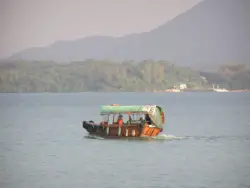
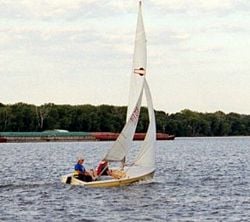
| — |
|
|
|
Unusual boats have been used for sports purposes - for example, in "big bathtub races" which use boats made from bathtubs. Pumpkins have been used as boats as in the annual Pumpkin Boat Race on Lake Otsego in New York state, USA. In this race, very large, hollowed out pumpkin shells are used for boats, powered by canoe paddles.
Boat building materials
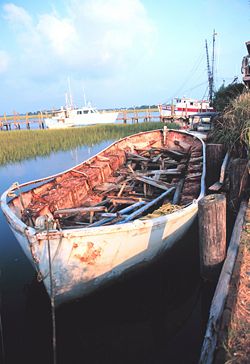
Until the mid 19th century most boats were of all natural materials; primarily wood. Many boats had been built with iron or steel frames but still planked in wood. In 1855 ferro-cement boat construction was patented by the French. They called it Ferciment. This is a system by which a steel or iron wire framework is built in the shape of a boat's hull and covered (troweled) over with cement. Reinforced with bulkheads and other internal structure it is strong but heavy, easily repaired, and, if sealed properly, will not leak or corrode. These materials and methods were copied all over the world, and have faded in and out of popularity to the present. As the forests of Britain and Europe continued to be over-harvested to supply the keels of larger wooden boats, and the Bessemer Process (patented in 1855) cheapened the cost of steel, steel ships and boats began to be more common. By the 1930s boats built of all steel from frames to plating were seen replacing wooden boats in many industrial uses, even the fishing fleets. Private recreational boats in steel are uncommon. In the mid 20th century aluminium gained popularity. Though much more expensive than steel, there are now aluminum alloys available that will not corrode in salt water, and an aluminum boat built to similar load carrying standards could be built lighter than steel.Nowdays fibre glass is dominating boat industry.
Platt Monfort invented Wire Plank(r)(1969), Fer-a-Lite(r)(1972), Str-r-etch Mesh(r)(1975), and Geodesic Airolite Boats(r)(1981). Fer-A-Lite(r) is a mixture of polyester resin, fiberglass, and a filler. This, along with Str-r-etch Mesh(r), could be used to build a boat in the same fashion as a ferro-cement boat, but the resulting hull would be much lighter and more resilient. Wire Plank(r) was first used in ferro-cement construction, but could also be used with Fer-a-Lite to create a medium to heavy weight hull. Geodesic Airolite Boats(r) are built using very lightweight wooden frames (geodesic) that are covered over with some lightweight heatshrinkable plastic or a synthetic fabric such as dacron coated with sealant. This tensioned skin adds to the overall strength of the structure and boats built thus are of the ultra-light variety. Boats come in many different shapes and sizes. Why? SO that some boats will be used perfectly against different types of waves.
Around the mid 1960s, boats made out of glass-reinforced plastic, more commonly known as fiberglass, became popular, especially for recreational boats. The coast guard refers to such boats as 'FRP' (for Fiberglass Reinforced Plastic) boats. Fiberglass boats are extremely strong, and do not rust, corrode, or rot. They are, however susceptible to structural degradation from sunlight and extremes in temperature over their lifespan. Fiberglass provides structural strength, especially when long woven strands are laid, sometimes from bow to stern, and then soaked in epoxy or polyester resin to form the hull of the boat. Whether hand laid or built in a mold, FRP boats usually have an outer coating of gelcoat which is a thin solid colored layer of polyester resin that adds no structural strength, but does create a smooth surface which can be buffed to a high shine. One of the disadvantages of fiberglass is that it is heavy and to alleviate this, various lighter components can be incorporated into the design. One of the more common methods is to use cored FRP, with the core being balsa wood completely encased in fiberglass. Cored FRP is most often found in decking which helps keep down weight that will be carried above the waterline. While this works, the addition of wood makes the cored structure of the boat susceptible to rotting. The phrase 'advanced composites' in FRP construction may indicate the addition of carbon fiber, kevlar(tm) or other similar materials, but it may also indicate other methods designed to introduce less expensive and, by at least one yacht surveyor's eyewitness accounts [1], less structurally sound materials.
Cold molding is similar to FRP in as much as it involves the use of epoxy or polyester resins, but the structural component is wood instead of fiberglass. In cold molding very thin strips of wood are laid over a form or mold in layers. This layer is then coated with resin and another directionally alternating layer is laid on top. In some processes the subsequent layers are stapled or otherwise mechanically fastened to the previous layers, but in other processes the layers are weighted or even vacuum bagged to hold layers together while the resin sets. Layers are built up thus to create the required thickness of hull.
People have even made their own boats or watercraft out of commonly available materials such as styrofoam or plastic, but most homebuilts today are built of plywood and either painted or covered in a layer of fiberglass and resin.
Boat propulsion
The most common means are:
- Human power (rowing, paddling, setting pole etc.)
- Wind power (sailing)
- Motor powered screws
- Inboard
- Internal Combustion (gasoline, diesel)
- Steam (Coal, fuel oil)
- Nuclear (for large boats)
- Inboard/Outboard
- Gasoline
- Diesel
- Outboard
- Gasoline
- Electric
- Paddle Wheel
- Water Jet (Jet ski, Personal water craft, Jetboat)
- Air Fans (Hovercraft, Air boat)
- Inboard
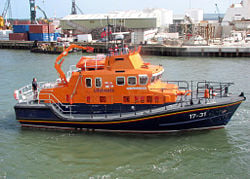
Why boats float
- See also buoyancy
A boat stays afloat because its weight is equal to that of the water it displaces. The material of the boat itself may be heavier than water (per volume), but it forms only the outer layer. Inside it is air, which is negligible in weight. But it does add to the volume. The central term here is density, which is mass ('weight') per volume. The mass of the boat (plus contents) as a whole has to be divided by the volume below the waterline. If the boat floats, then that is equal to the density of water (1 kg/l). To the water it is as if there is water there because the average density is the same. If weight is added to the boat, the volume below the waterline will have to increase too, to keep the mass/weight balance equal, so the boat sinks a little to compensate.
See also
- Buoyancy
- Ship
ReferencesISBN links support NWE through referral fees
<<At least 3 reliable refs needed here.>>
External links
- World of Boats Boat museum in Scotland
- Hull Identification Numbers Explanation of International HIN formats
- University of Washington Libraries Digital Collections—Freshwater and Marine Image Bank—Vessels Images of boats and vessels.
- ConceptBoat.Dee-London.com - Southampton Boat Show 2007 photos
Credits
New World Encyclopedia writers and editors rewrote and completed the Wikipedia article in accordance with New World Encyclopedia standards. This article abides by terms of the Creative Commons CC-by-sa 3.0 License (CC-by-sa), which may be used and disseminated with proper attribution. Credit is due under the terms of this license that can reference both the New World Encyclopedia contributors and the selfless volunteer contributors of the Wikimedia Foundation. To cite this article click here for a list of acceptable citing formats.The history of earlier contributions by wikipedians is accessible to researchers here:
The history of this article since it was imported to New World Encyclopedia:
Note: Some restrictions may apply to use of individual images which are separately licensed.
